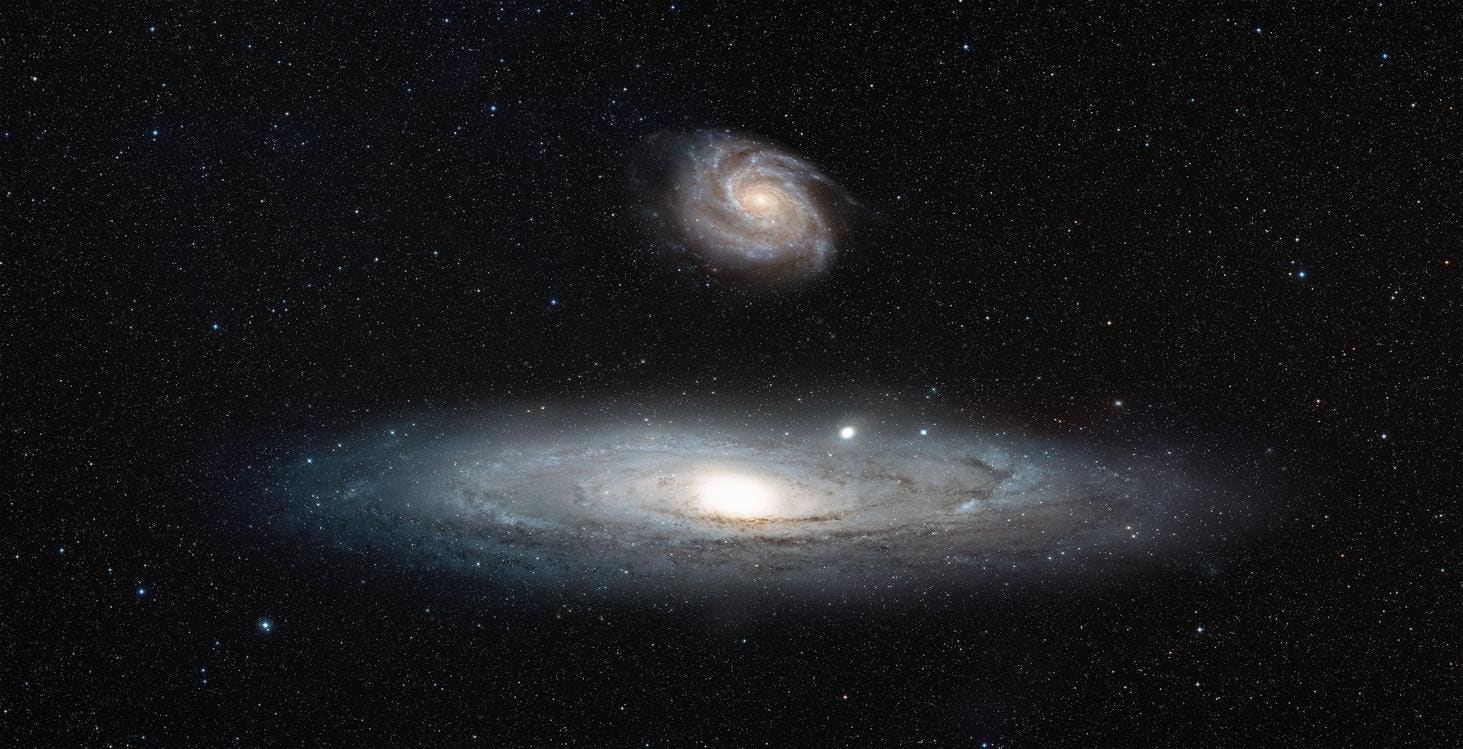Andromeda Galaxy : https://esahubble.org/images/heic1112e/ Milky Way Galaxy : … More
When will the Milky Way collide with the Andromeda Galaxy? It’s a common question because, for many years, astronomers have theorized that the two largest spiral galaxies in our cosmic neighborhood — our Milky Way and Andromeda (also called M31) will one day collide. An answer is normally offered: about four billion years.
Now, this decade-long belief is being challenged by new research that suggests the Milky Way and Andromeda may not be on a collision course after all. The study, published today in Nature Astronomy, reveals a 50% probability that the two galaxies will avoid crashing into each other within the next 10 billion years.
Welcome To The Andromeda Galaxy
Andromeda is 2.5 million light years from the Milky Way. Cmosmically speaking, that’s very close. It’s home to at least a trillion stars. The Milky Way, meanwhile, hosts about 100-400 billion stars (it’s hard to say because we’re in it, so our telescopes can’t see all of it).
The knowledge that Andromeda is moving toward the Milky Way is core to our understanding of an expanding universe. Having four years previously figured out that Andromeda — a fuzzy blob to the naked eye in dark skies — was an “island universe” (in other words, a galaxy), American astronomer Edwin Hubble calculated in 1929 that galaxies were moving away from the Milky Way, All of them, that is, except one — Andromeda. The universe was expanding, as Albert Einstein had predicted. However, Andromeda and the Milky Way are headed towards each other at 250,000 miles per hour.
Three future scenarios for Milky Way & Andromeda encounter. Top left: Galaxies bypass at 1 million … More
‘Milkomeda’ May Never Happen
Andromeda will dominate Earth’s night sky in about four billion light-years, goes the received wisdom. It will collide with the Milky Way in about five billion years, forming a new, larger galaxy — “Milkomeda.”
New research debunks this. Based on gravitational models that consider the influence of other celestial bodies in the Local Group of galaxies — specifically a number of dwarf galaxies orbiting the Milky Way — researchers at the University of Helsinki in Finland calculate that the Milky Way’s path through the cosmos has a high chance of missing Andromeda altogether. The research uses the latest data from the European Space Agency’s Gaia mission and NASA’s Hubble Space Telescope, along with revised mass estimates of surrounding galaxies.
Meet The Satellite Galaxies
The Milky Way is not alone. It exists with over 50 other galaxies called the Local Group, which also includes Andromeda. In orbit around the Milky Way are a number of dwarf galaxies, including the Small and Large Magellanic Clouds and the Triangulum galaxy (M33) — the latter half the size of our Milky Way and the third-largest galaxy in our local group of galaxies, according to NASA.
Those small galaxies affect the Milky Way’s path through space, according to the researchers, whose new data on the mass of those galaxies produces a new result. In particular, the gravitational pull of the LMC, whose mass was not considered in previous analyses, may explain it. As an aside, this paper also states that the LMC may merge with the Milky Way within the next two billion years.
The Andromeda Galaxy. (Photo by: Alan Dyer /VW PICS/Universal Images Group via Getty Images)
Already Entangled?
Given that the movement of Andromeda is the basis for our understanding of the entire universe, there’s been a lot of research into its movements. In 2019, researchers reported that Andromeda had already consumed several smaller galaxies within the last few billion years. In 2023, another paper argued that the Milky Way and Andromeda are, in effect, already interacting since ancient stars in the Milky Way’s halo are about halfway to Andromeda and that a halo of gas around both galaxies is already entwined.
Whether or not Andromeda collides with the Milky Way or not in four billion years is, for Earthlings, somewhat academic. By that time, the sun will have used up its hydrogen fuel and be expanding into a red giant star, boiling away Earth’s oceans as it does so and possibly even consuming the entire planet.
Wishing you clear skies and wide eyes.








